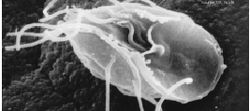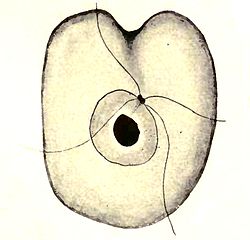Amoebozoa
The Amoebozoa are a eukaryote phylum of Amoeba-like protozoa.[2] They are a sister clade to the fungi and the animals.[3] Most move by internal cytoplasmic flow. Their finger-like pseudopodia are characteristic.
| Amoebozoa | |
|---|---|

| |
| Chaos carolinensis | |
| Scientific classification | |
| Unrecognized taxon (fix): | Amorphea/showdomain |
| Phylum: | Amoebozoa Lühe, 1913 emend. Cavalier-Smith, 1998 |
| Subphyla, infraphyla and classes | |
| Synonyms | |
| |
They are a major group with about 2,400 described species of amoeboid protists.[4][5][6] In most classification schemes, Amoebozoa is ranked as a phylum in either the kingdom Protista[7] or the kingdom Protozoa.[8] In the classification of the International Society of Protistologists, it is kept as an unranked "supergroup" in the Eukaryota.[5]
Sequence analysis shows Amoebozoa is a monophyletic clade. Most phylogenetic trees identify it as the sister group to Opisthokonta. That is another major clade which contains both fungi and animals as well as some 300 species of unicellular protists.[4][9] Amoebozoa and Opisthokonta are sometimes grouped together in a high-level taxon, called Unikonta,[8] Amorphea,[5] or Opimoda.[10]
Amoebozoa includes many of the best-known amoeboid organisms, such as Chaos, Entamoeba, Pelomyxa and the genus Amoeba itself.
Most are unicellular, and are common in soils and aquatic habitats. Some are symbionts of other organisms, including several pathogens.The Amoebozoa also include the mycetozoan slime moulds, multinucleate or multicellular forms which produce spores and can usually be seen by eye.[11]
Nutrition is usually by phagocytosis. The cell surrounds food particles, sealing them into vacuoles where they are digested and absorbed. When food is scarce, most species form cysts, which may be carried by air to other places. In slime moulds, these structures are called spores, and form on stalked structures called fruiting bodies or sporangia.
Most Amoebozoa lack flagella and more generally do not form microtubule-supported structures except during mitosis. However, flagella occur among some archamoebae, and many slime moulds produce biflagellate gametes.
A characteristic form is the model organism Dictyostelium discoideum.
Amoebozoa Media
Arcella sp. test (Lobosa: Tubulinea)
Acanthamoeba sp. (Lobosa: Discosea)
References
- ↑ Parfrey LW, Lahr DJ, Knoll AH, Katz LA (August 2011). "Estimating the timing of early eukaryotic diversification with multigene molecular clocks". Proceedings of the National Academy of Sciences of the United States of America. 108 (33): 13624–9. doi:10.1073/pnas.1110633108. PMC 3158185. PMID 21810989.
- ↑ Patterson, David J. (1999). "The Diversity of Eukaryotes". The American Naturalist. 154 (S4): S96–S124. doi:10.1086/303287. JSTOR 10.1086/303287. PMID 10527921. S2CID 4367158.
- ↑ Song Ji and others 2005. Comparing the Dictyostelium and Entamoeba genomes reveals an ancient split in the Conosa lineage. [1]
- ↑ 4.0 4.1 Pawlowski J. 2012; et al. (2012). "CBOL Protist Working Group: barcoding eukaryotic richness beyond the animal, plant, and fungal kingdoms". PLOS Biology 10(11). 10 (11): e1001419. doi:10.1371/journal.pbio.1001419. PMC 3491025. PMID 23139639.
- ↑ 5.0 5.1 5.2 Adl S.M.; et al. (2012). "The revised classification of eukaryotes". Journal of Eukaryotic Microbiology. 59 (5): 429–514. doi:10.1111/j.1550-7408.2012.00644.x. PMC 3483872. PMID 23020233.
- ↑ Cavalier-Smith T.; et al. (2015). "Multigene phylogeny resolves deep branching of Amoebozoa". Molecular Phylogenetics and Evolution. 83: 293–304. doi:10.1016/j.ympev.2014.08.011. PMID 25150787. Retrieved April 7, 2015.
- ↑ Corliss, John O. (1984). "The Kingdom Protista and its 45 phyla". BioSystems 17.2 (1984): 87-126. 17 (2): 87–126. doi:10.1016/0303-2647(84)90003-0. PMID 6395918.
- ↑ 8.0 8.1 Cavalier-Smith, Thomas (2003). "Protist phylogeny and the high-level classification of Protozoa". European Journal of Protistology. 39 (4): 338–348. doi:10.1078/0932-4739-00002.
- ↑ Cavalier-Smith; et al. (2015). "Multigene phylogeny resolves deep branching of Amoebozoa". Molecular Phylogenetics and Evolution. 83: 293–304. doi:10.1016/j.ympev.2014.08.011. PMID 25150787. Retrieved April 7, 2015.
- ↑ Derelle; et al. (2015). "Bacterial proteins pinpoint a single eukaryotic root". Proceedings of the National Academy of Sciences. 112 (7): E693–E699. doi:10.1073/pnas.1420657112. PMC 4343179. PMID 25646484.
- ↑ Schilde, C.; Schaap, P. (2013). "The Amoebozoa". Dictyostelium discoideum Protocols. Methods in Molecular Biology. Vol. 983. pp. 1–15. doi:10.1007/978-1-62703-302-2_1. ISBN 978-1-62703-301-5. PMC 4037983. PMID 23494299.









